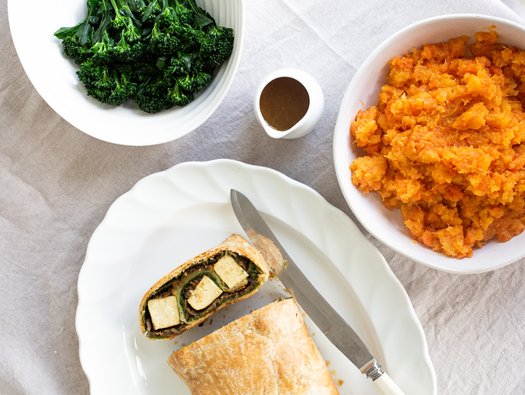Vegan Wellington

This tofu Wellington is a showstopping, flavour-packed centrepiece – beautifully crafted to be low in potassium, salt and phosphate for kidney-friendly dining without compromise.

This tofu Wellington is a showstopping, flavour-packed centrepiece – beautifully crafted to be low in potassium, salt and phosphate for kidney-friendly dining without compromise.
40g fresh spinach
60g plain flour
220ml almond milk
Ground black pepper
1 teaspoon sunflower oil
2 garlic gloves, finely diced
Half an onion, finely diced
200g brown mushrooms, finely diced
2 large carrots (200g), finely grated
Leaves from 4 sprigs of thyme
1 teaspoon smoked paprika
1 pack (320g) vegan puff pastry
280g pack firm tofu (Naked/plain), cut in half through the middle and then into 3 strips, leaving you with 6 pieces
4 large carrots (400g), peeled and sliced
1 small swede (approximately 450g), peeled and diced
25g vegan butter
250ml low-salt vegetable stock
15g plain flour
200g broccoli, cut into florets
Pre-heat the oven to 180°C / 160°C fan / gas mark 4. Add the raw spinach, flour, 200ml of the almond milk and ground black pepper to a blender and blend until smooth and thick. Put the sunflower oil into a non-stick frying pan and fry the spinach pancake mixture on both sides on a low heat. When cooked through, carefully peel the pancake out of the pan and set aside. You may need to make two pancakes to use all of the batter.
In the same oiled pan, fry the garlic on a low heat until fragrant and add the onion, frying for another 5 minutes before adding the diced mushrooms, grated carrots, thyme leaves, smoked paprika and ground black pepper to taste. Sauté the mixture until golden brown and cooked through. Leave to cool.
When the mushroom and carrot mixture is slightly cooled, tip into the blender and blitz a few times to retain a coarse texture; return it to the frying pan and cook for a few minutes to remove the moisture. Set aside.
Unroll the ready-rolled pastry onto a board. Lay the 2 spinach pancakes side by side on top of the pastry. Spread the mushroom and carrot mixture over the spinach layer, ensuring it covers evenly. Place the 6 tofu strips on top, so that they cover the whole length of the rectangle.
Using a long knife to hold the tofu in place, gently roll up the pastry rectangle and tuck the ends in, so that it forms a rectangular pastry parcel with the fillings inside. Using a pastry brush, brush the remaining 20ml of almond milk across the top of the pastry and the open ends and close the ends of the pastry parcel with your fingertips. Place on a greased baking tray and bake in the oven for 30–40 minutes, until the pastry is golden brown.
While the Wellington is baking, tip the swede and carrot pieces into a saucepan, cover with cold water and bring to the boil. Simmer for 15 minutes or until the vegetables are cooked. Drain the water off and, adding the butter, mash together, seasoning with black pepper. In a jug, whisk the flour into the stock to thicken it into a gravy.
When the Wellington is cooked, remove from the oven and leave to cool while boiling the broccoli in a pan. Serve the Wellington with the swede and carrot mash and broccoli on the side, with gravy poured over.
The pastry is the main source of carbohydrate in this recipe, and the value has been provided for those who have been trained in insulin adjustment.
Despite the use of the high potassium ingredient, mushrooms, this recipe is low in potassium, when following the quantities in the ingredients, and the serving sizes. Therefore, this dish is suitable for those advised to lower potassium in their diet.
This recipe is also low in phosphate, however it does contain some phosphate, mainly provided by the tofu, pastry and almond milk, therefore if you have been prescribed a phosphate binder you should take as directed.
This recipe is low in protein, therefore suitable for those advised to eat less protein.
You can substitute ½ teaspoon of dried thyme for the fresh herb. The Wellington can also be served with frozen broccoli or peas.
Once cooked and cooled, this recipe can be stored in an airtight container in the fridge and reheated for the following day. This dish is best eaten freshly made.
By giving us your email address, you're giving us permission to send you the latest news from Kidney Care UK. Further information about how we protect and use your personal data is available in our Privacy policy. If you would like to change the way we communicate with you at any time please email [email protected]. You can unsubscribe at any time by using the link at the bottom of every email we send.